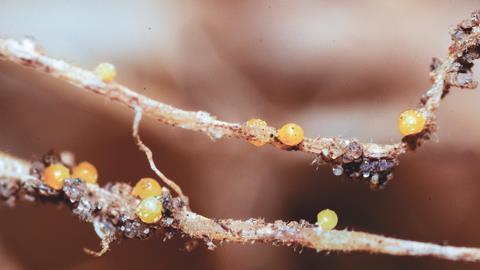UK retailers criticised for dragging their heels in the uptake of resistant varieties as growers search for solutions in fight against pallida
Despite talking a good game on sustainability and encouraging growers to reduce the use of pesticides, UK supermarkets have so far been slow to embrace PCN-resistant varieties of potato.
This was the assessment of a major potato breeder who told FPJ that seed houses have generally been disappointed with the limited traction for resistant varieties in Britain.
There is a perception that varieties with resistance to Potato Cyst Nematode – the primary potato pest in the UK – are more prone to after-cooking darkening, he said.
Given the high standard of potatoes in key production countries such as Britain, Ireland, France and the Netherlands, none of the retailers “want to take a backwards step” when it comes to cooking quality and culinary characteristics.
“They might say otherwise, but the guys in the supermarkets are not really that concerned with the technical challenges growers that face,” he said. “They want to get a product on the shelf, and they’re competing with the other supermarkets on price and quality.”
Asked whether he can see retailers giving more support to resistant varieties in future, he suggested they may soon have little other choice.
He made the point that growers in certain parts of England “are getting hammered on yield” because of PCN and will either have to stop growing potatoes in infested fields or find resistant varieties.
“It’s very unlikely that another chemical solution or soil fumigant will come along, and it’s unlikely that some of the other crops that suppress the PCN population will make significant strides,” he said. “The obvious big game changer would be a variety with significant resistance.”
James Lee, head of agronomy at Produce Solutions, which provides technical advice and support to potato growers, recently spoke to FPJ in a separate interview. He said: “Management of the PCN challenge was primarily focused on the use of plant protection products, however as the number of effective plant protection products has declined, so the use of more integrated approaches to PCN management has increased.
“If the industry loses any further of the more effective nematicides, the use of the remaining integrated approaches to PCN control may not be sufficiently effective to maintain commercial potato production in highly infested fields, and many of current popular varieties may be lost.”
Another major breeder emphasised that varietal resistance is the greatest tool growers have to combat the pest. But he said there was still plenty of work to do to bring through high-quality PCN-resistant varieties, especially in the fresh potato sector.
An important challenge for breeders is to get better at marketing resistant varieties to packers and retailers, and to teach growers how to grow the varieties to their full potential, he argued.
“If you tell the story about a variety, then customers will feel more engaged to cook it differently and to understand why it needs to be cooked differently,” he explained.
Potato Cyst Nematode (PCN) is the main potato pest in the UK and infestation can result in yield losses of over 80 per cent.
Overall, the pest is estimated to cost the UK potato industry approximately £50 million per year, according to the independent agricultural and environmental consultancy ADAS.
Most plant damage is caused when juvenile nematodes emerge from cysts and infest plant roots. PCN infestation can cause wilting, stunted growth, and other symptoms indicative of root damage and stress.
According to GB Potatoes, 48 per cent of England and Wales and 35 per cent of Scotland’s ware land is infected with PCN.
There are two species of the pest, white PCN (Globodera pallida) and yellow PCN (G. rostochiensis), but the former is more common.
A PCN cyst can contain 200-600 eggs and once present in the soil, the cyst can persist for over 10 years. The eggs are stimulated to hatch by potato root exudates.
Once land is infested with PCN, it is “very difficult” to eliminate, ADAS warns, “so management strategies generally focus on maintaining pest numbers at levels where they have a minimal impact on the crop”.




